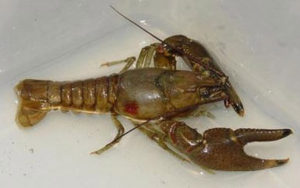By David Cederstrom, Chronicle Staff Writer
The Lake George Park Commission’s boat inspection program intercepted “a whole bucketful” of invasive rusty crayfish last summer and kept them out of the lake, Commission executive director Dave Wick tells The Chronicle.
He said it was “the first time we’ve ever seen anybody bring it up to Lake George” in the three years of the inspection program.
“It was kind of a pretty good ‘catch’” by the inspectors, Mr. Wick said.
A fisherman had trapped the crayfish around the intersection of Schoharie Creek and the Mohawk River, and “brought them up just as bait,” Mr. Wick said.
“One of the questions that we ask in the inspection process is, ‘Do you have any bait on board?’” The fisherman said he had a bucket of crayfish.

The boat inspectors have cards identifying invasive species, including the rusty crayfish, Mr. Wick said. Other Commission staff confirmed the identification, and the bucketful was confiscated.
“The size and aggressive behavior of rusty crayfish allow it to outcompete native crayfish and minimize predation from other fish,” says the website of the New York State Department of Environmental Conservation (DEC).
“….Rusty crayfish can also alter aquatic plant habitat and prey on fish eggs, further impacting native crayfish and fish populations.”
DEC says, “The rusty crayfish (Orconectes rusticus) has spread to New York State from the central and midwestern U.S., most likely through bait buckets.”
DEC regulations specifically prohibit use of the crustacean as bait: “Rusty crayfish may not be purchased and/or transported to a water body for use as bait or released. Rusty crayfish may not be transported away from or within a water body.”
“The size and aggressive behavior of rusty crayfish allow it to outcompete native crayfish and minimize predation from other fish,” says DEC. “….Rusty crayfish can also alter aquatic plant habitat and prey on fish eggs, further impacting native crayfish and fish populations.”
Rusty crayfish are larger than native New York crayfish. The U.S. Geological Survey (USGS) says the invader can grow to four inches and has claws larger and more robust than other crayfish species. They have a dark brown body with rusty red spots on the sides of the carapace.
Native to the Ohio River basin, they have spread to 20 states beyond their home range, and to Ontario, Canada, says the USGS.
It says rusty crayfish are not picky eaters, consuming a variety of aquatic plants, benthic invertebrates such as mayflies and stoneflies, detritus, algae, fish eggs and small fish.
DEC notes that bait bucket water can contain other invasive species such as zebra mussel larva and spiny waterfleas.
Copyright © 2016 Lone Oak Publishing Co., Inc. All Rights Reserved.
 Glens Falls Chronicle Serving the Glens Falls/Lake George region; Warren, Washington and northern Saratoga counties since 1980
Glens Falls Chronicle Serving the Glens Falls/Lake George region; Warren, Washington and northern Saratoga counties since 1980


